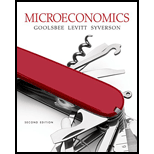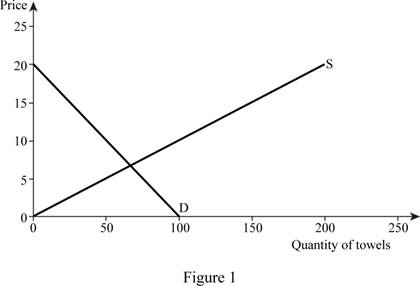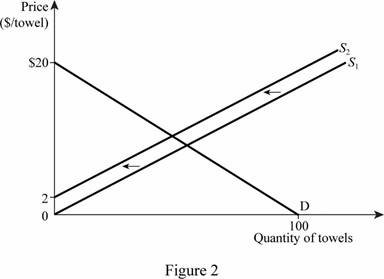
(a)
Graph the inverse supply curve demand curve.
(a)
Explanation of Solution
Given information:
Demand function for towel:
Supply function for towel:
Calculation:
Rearrange Equation (1) in terms of price of that goods to derive the inverse demand equation.
The inverse demand equation is
Rearrange Equation (2) in terms of price of that good to derive the inverse supply equation.
The inverse supply function is
Substitute quantity as zero in Equation (3) to calculate the price.
The maximum willing price is $20.
Substitute price as zero in Equation (3) to calculate the quantity.
The maximum willing quantity is 100 units.
Substitute quantity as 0 in Equation (4) to calculate the price.
The minimum willing price is 0.
Substitute quantity as 200 units in Equation (4) to calculate the price.
The minimum willing quantity is 20.
From these information, the inverse demand and supply curve are shown in Figure 1 below.

In Figure 1, the vertical axis measures the price of the towel and horizontal axis measures the quantity of the towel. The upward sloping curve “S” is the supply curve of the towel and downward sloping curve “D” is the demand curve for the towel.
Demand curve: Demand curve shows the quantity demand at different price levels.
(b)
(b)
Explanation of Solution
Intersecting point of the demand and supply curve is the equilibrium point. The corresponding price and quantity are the equilibrium price and quantity. Equilibrium price can be calculated as follows:
Equilibrium price is $6.67.
Equilibrium price can be calculated by substituting the equilibrium price into supply equation (Equation (2)).
Equilibrium price: The equilibrium price is the market price determined by the interaction between the quantity demanded and the quantity supplied.
Equilibrium quantity: The equilibrium quantity is the point where the quantity demanded is equal to the quantity supplied.
(c)
New inverse supply curve.
(c)
Explanation of Solution
Given information:
At each price, 20 fewer towels are offered for sale.
Calculation:
At each price, 20 fewer towels are offered for sale. Thus, the new inverse supply curve is shown below:
Substitute quantity as zero in Equation (5) to calculate the price (minimum willing price).
The minimum willing price is $2.
Substitute quantity as 110 in Equation (5) to calculate the price.
The minimum willing price is $2.
By using this information, change in supply curve of towel is shown in Figure 2 below.

In Figure 2, the vertical axis measures the price of the towel and horizontal axis measures the quantity of the towel. The upward sloping curve “S1” is the supply curve of the towel and downward sloping curve “D” is the demand curve for the towel. The reduction in 20 fewer towels shifts the supply curve to the left. Thus, curve “S2” is the new inversee supply curve, where the minimum willing price is 2.
Supply curve: Supply curve shows the quantity supplied at different price levels.
(d)
Equilibrium price and quantity.
(d)
Explanation of Solution
The calculation of equilibrium price is shown below:
Equilibrium price is $8.
Equilibrium quantity can be calculated by substituting the equilibrium price in to new supply equation (Equation (5)).
Equilibrium quantity is 60 units.
Equilibrium price: The equilibrium price is the market price determined by the interaction between the quantity demanded and the quantity supplied.
Equilibrium quantity: The equilibrium quantity is the point where the quantity demanded is equal to the quantity supplied.
(e)
Equilibrium price and quantity.
(e)
Explanation of Solution
At each price, 25 fewer towels are offered for sale. Thus, the new inverse demand curve is shown below:
Equilibrium price can be calculated as follows:
Equilibrium price is $5.
Equilibrium quantity can be calculated by substituting the equilibrium price in to new demand equation (Equation (6)).
Equilibrium quantity is 50 units. The equilibrium quantity and price are reducing. The new equilibrium price and quantity are less than the initial equilibrium quantity and price.
Equilibrium price: The equilibrium price is the market price determined by the interaction between the quantity demanded and the quantity supplied.
Equilibrium quantity: The equilibrium quantity is the point where the quantity demanded is equal to the quantity supplied.
Want to see more full solutions like this?
Chapter 2 Solutions
Microeconomics (Instructor's)

 Principles of Economics (12th Edition)EconomicsISBN:9780134078779Author:Karl E. Case, Ray C. Fair, Sharon E. OsterPublisher:PEARSON
Principles of Economics (12th Edition)EconomicsISBN:9780134078779Author:Karl E. Case, Ray C. Fair, Sharon E. OsterPublisher:PEARSON Engineering Economy (17th Edition)EconomicsISBN:9780134870069Author:William G. Sullivan, Elin M. Wicks, C. Patrick KoellingPublisher:PEARSON
Engineering Economy (17th Edition)EconomicsISBN:9780134870069Author:William G. Sullivan, Elin M. Wicks, C. Patrick KoellingPublisher:PEARSON Principles of Economics (MindTap Course List)EconomicsISBN:9781305585126Author:N. Gregory MankiwPublisher:Cengage Learning
Principles of Economics (MindTap Course List)EconomicsISBN:9781305585126Author:N. Gregory MankiwPublisher:Cengage Learning Managerial Economics: A Problem Solving ApproachEconomicsISBN:9781337106665Author:Luke M. Froeb, Brian T. McCann, Michael R. Ward, Mike ShorPublisher:Cengage Learning
Managerial Economics: A Problem Solving ApproachEconomicsISBN:9781337106665Author:Luke M. Froeb, Brian T. McCann, Michael R. Ward, Mike ShorPublisher:Cengage Learning Managerial Economics & Business Strategy (Mcgraw-...EconomicsISBN:9781259290619Author:Michael Baye, Jeff PrincePublisher:McGraw-Hill Education
Managerial Economics & Business Strategy (Mcgraw-...EconomicsISBN:9781259290619Author:Michael Baye, Jeff PrincePublisher:McGraw-Hill Education





